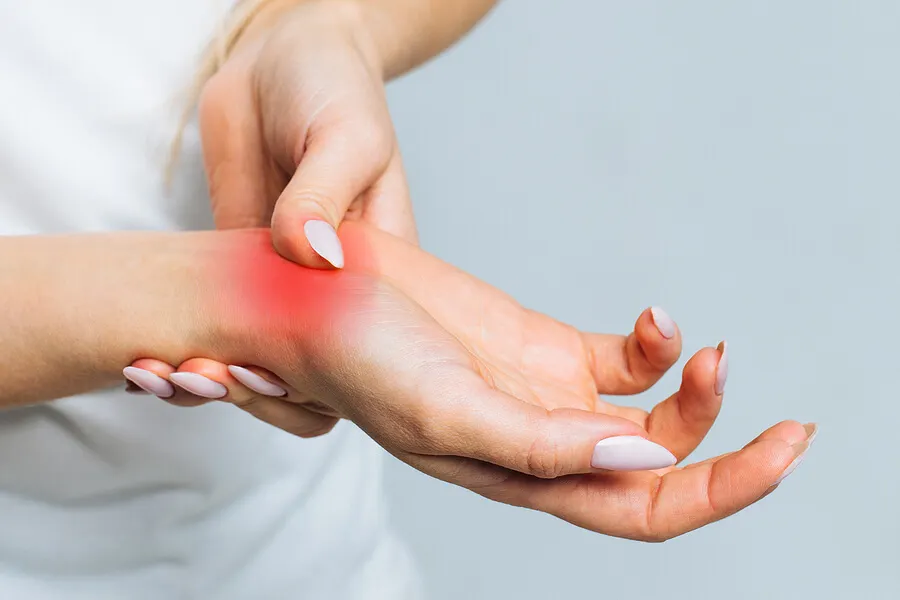Wrist Tendonitis: Symptoms, Causes, and Treatments


Written and verified by the doctor Mariel Mendoza
Wrist tendonitis is caused by an inflammatory, chronic and degenerative process of the fibrous structure (tendon) that joins the muscle to the bone. Several tendons make up the wrist, and several may be affected simultaneously.
The injury usually occurs when the tendon crosses another or over a bony prominence. It manifests with pain and tenderness around the wrist that may be long-term.
The anatomy of the wrist
The area between the forearm and the hand is the area known as the wrist. Bone-wise, it contains the distal part of the forearm bones (radius and ulna) and the initial part of the carpal bones that join with them.
There are many joints that exist between the bones in this area. Meanwhile, even more ligaments are responsible for joining the bones to the muscles, giving the wrist stability and mobility.
At the wrist, tendons connect the forearm muscles to the bones of the hand and fingers. These tendons fall into two categories: flexors and extensors.
In addition, these tendons are surrounded by a sheath lined with synovial tissue. The sheath and the tendon contain synovial fluid, which allows the tendons to glide. Pathological inflammation occurs not only directly in the tendon, but also in this area.

What is wrist tendonitis?
Wrist tendinitis is considered a chronic and degenerative condition, as the symptoms are often not evident until a significant period has elapsed. Typically, they’re more common in the right hand, because it’s the dominant or skilled hand in most of the population. The average age of diagnosis is between the fifth and sixth decade of life (50-60 years old).
There are different variants of wrist tendinitis. These include De Quervain’s tenosynovitis, intersection syndrome, and sixth compartment syndrome.
De Quervain’s tenosynovitis is the most commonly diagnosed type of tendonitis. This variant of wrist tendonitis is a stenosing (i.e., constrictive) tenosynovitis of the tendon sheaths of the thumb extensors on the lateral aspect of the wrist. It manifests with pain and functional limitation of the big toe.
Tendonitis, tenosynovitis, or peritendinitis?
By definition, tendonitis is the inflammatory and degenerative process of the tendon, while tenosynovitis refers to the inflammation of the synovial sheath covering the tendons. Meanwhile, peritendinitis is the inflammatory process that occurs right at the intersection between the muscle and tendon.
You might like: Relieve Back Pain with a Simple Breathing Technique
The causes of wrist tendonitis are associated with the overuse of the joint
There are many different causes of wrist tendonitis, but most are based on the loss of tendon elasticity due to aging (and the consequent loss of collagen) and overuse of the joints, in conjunction with mechanical loading.
Here, “mechanical loading” refers to the combination of heavy use with repetitive movements and the strength and position of the wrist. Basically, any action that generates repeated and prolonged stress on muscles and tendons can cause this condition.
Wrist tendinitis is part of common occupational medicine conditions. In fact, specialists believe that the prevalence of hand and wrist conditions in manual workers is up to 45%.
In the workplace, wrist tendonitis is caused by repetitive manual movements, such as the use of a typewriter, a computer, or a cell phone. The use of equipment involving force between the thumb and index finger also causes the disorder.
We think you’ll like to read: Advice on How to Sleep with Shoulder Tendonitis
The symptoms of wrist tendinitis
The main symptom of wrist tendonitis is intense pain around the area when performing movements or holding objects. Meanwhile, if the causative factor is sustained over time, the symptoms progress to persistent pain even with rest.
Overall, you may also notice the following symptoms if you have wrist tendonitis:
- Tenderness
- Swelling
- Redness
- Local warmth
- Tingling
At first, symptoms may subside or improve with the cessation of repetitive motion or during rest. However, in the long term, the pain often becomes persistent.
Wrist tendonitis requires medical evaluation
Any symptoms of wrist tendinitis should be referred to a doctor specializing in the musculoskeletal system, i.e., a traumatologist or an orthopedist. The professional will make the diagnosis by questioning you and performing a physical examination.
At the time of consultation, there’s usually evidence of joint stiffness, swelling, and pain when moving the wrist.
The diagnosis is clinical. However, in some cases, a soft tissue ultrasound or MRI is requested to assess the affected tendon and the extent of inflammation more accurately. A wrist X-ray may also be used to rule out bone injury in case of trauma.
The treatment of wrist tendinitis
The treatment of wrist tendinitis will depend on its severity. However, it always starts with conservative, non-invasive medical treatment.
Typically, this approach consists of the following:
- Resting the joint
- Immobilizing the joint for three weeks
- A prescription of non-steroidal anti-inflammatory drugs
- Physical rehabilitation exercises
In very painful cases, doctors may consider cortisone injections or anesthetics. When the conservative approach doesn’t help to resolve the symptoms, doctors may also turn to surgical treatment.
Immobilization of the writs may be recommended for up to three weeks as a part of treatment.Some final tips
To prevent relapses in cases of wrist tendonitis, the most important recommendation is to modify the activity that seems to be the source of the problem. If you still need to use your hands extensively daily, it’s a good idea to change the resting position of your wrist or use a wrist brace.
In addition, exercises to stretch and warm up the muscles and tendons should be performed before any physical exercise. Ice to reduce inflammation may also help.
All cited sources were thoroughly reviewed by our team to ensure their quality, reliability, currency, and validity. The bibliography of this article was considered reliable and of academic or scientific accuracy.
- Castel A. Tendinitis y Tenosinovitis de Muñeca y Mano. Revista Iberoamericana de Cirugía de la Mano 2010;2(38).
- Medina C, Benet M, Marco F. El complejo articular de la muñeca: aspectos anatofisiológicos y biomecánicos, características, clasificación y tratamiento de la fractura distal del radio. Med Sur 2016;4(14). Disponible en http://medisur.sld.cu/index.php/medisur/article/view/3361.
- Thomsen J, Mikkelsen S, Andersen J, Fallentin N, Loft I, Frost P, et al. Risk factors for hand-wrist disorders in repetitive work. Occup Environ Med 2007; 64:527–533. Disponible en https://pubmed.ncbi.nlm.nih.gov/17387137/.
- Zepeda J, Carranza A. Determinación de factores causantes de Tendinitis de Muñeca. Rev. Fac. Med 2017;1(23).
This text is provided for informational purposes only and does not replace consultation with a professional. If in doubt, consult your specialist.








